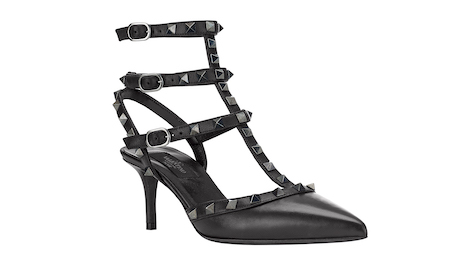 Valentino Garavani Rockstud shoes. Image courtesy of Valentino
Valentino Garavani Rockstud shoes. Image courtesy of Valentino
As most have heard, Amazon is participating in a lawsuit with Italian fashion brand Valentino against one of Amazon’s third-party sellers for vending counterfeit Valentino’s Garavani Rockstud shoes.
This move by Amazon is merely a marketing ploy because Amazon has been struggling – and justifiably so – to entice luxury brands to its site.
To date, we have heard several feel-good stories and attempts by Amazon to enter the luxury market. But it is doubtful that, without real change, Amazon will earn the trust it needs from luxury brands.
Who’s bidding?
This author applauds Valentino for using Amazon in the litigation (see story). It is the least Amazon can do while it outwardly condones the sale of counterfeit products ranging from luxury products to toothpaste.
Despite its statement, “this joint lawsuit builds on Amazon’s history of collaborating with brands to hold counterfeiters accountable,” Amazon allows, or at least does not disallow, trademark bidding.
Trademark bidding is the use of a brand name to redirect traffic away from the brand and/or authorized reseller and unto another site.
For example, if you go to Amazon’s Web site and do a quick search for “Hermes scarf,” you will receive more than 180 hits: https://www.amazon.com/s?k=hermes+scarf&ref=nb_sb_noss_2.
While some of the scarves do not use the Hermès trademark, it is clear that they are being sold by using the goodwill of the Hermès brand.
By way of another example, a search for “LV Neverfull” yields 38 results (https://www.amazon.com/s?k=LV+neverfull&ref=nb_sb_noss), but most of the counterfeit handbags available are being offered at nearly double the price of the authentic handbag that consumers can purchase directly from Louis Vuitton’s Web site at www.vuitton.com.
Here, the Louis Vuitton sellers are more insidious than the Hermès sellers because they are using the LV protected mark in addition to the company’s goodwill.
Equally troubling, it does not appear that Amazon is monitoring sales or customer communications.
For example, the following is a customer service chat with a buyer of a fake Louis Vuitton and a seller. Even more blatant, that seller is trying to sell Louis Vuitton at more than double the price of an authentic Louis Vuitton.
Below is that actual chat from March:
Watch this seller! They double the price, ($2,700 vs $1,350) from the Louis Vitton (sic) store direct! Why does Amazon let them get away with this? Fortunately they were out of stock and order was cancelled.
By Greg on January 22, 2020.
The price reflects Amazon 35% commission, international priority mail from Europe, customs fees and insurance.
By Personal Wellness - Luxury Goods on March 4, 2020.
If the counterfeit sellers themselves blame Amazon for their deleterious acts, why should not consumers?
To gain brand and consumer trust, Amazon must do more than occasionally join a lawsuit related to counterfeiting. It should, at a minimum, prohibit trademark bidding, scan its sight for obvious counterfeits, and takedown counterfeit product listings.
While it will be nearly impossible for Amazon to catch 100 percent of counterfeiters, with its proprietary algorithms and deep pockets, it should be able to achieve measurable success.
Amazon, through Amazon Renewed – pre-owned, refurbished and open box items – provides counterfeiters with an entirely new platform to peddle their fake wares.
A quick search for “Chanel” will allow you to buy a purported velvet flap bag for $6,550.
Tip top
Best practices dictate that Amazon take genuine steps to curtail the sale of counterfeits. A few are below:
- Require all luxury items to be authenticated prior to being listed. Spend time creating a list of pre-approved authenticators. Hint: Reputable consignment shops can authenticate for a fee. Or, better yet, hire your own authentication team and disallow the sale of fakes. If Amazon can fulfill orders, it can authenticate items because they are in Amazon’s possession.
- Require that all items include at least two interior pictures, with one showing the brand’s mark. Often times, counterfeiters do not spend too much time on the interior of a handbag other than buckets and totes because they are rarely visible.
- Mandate that all listed items include the place and approximate date of purchase and/or location that the item was refurbished.
- Require that listings include the original MSRP.
- Require that sellers use their own pictures and not marketing pictures from the brand’s catalog, lookbook, social media or other source.
For brands, they should continue to communicate with their consumers.
Educate consumers about where they can find the brand and which second-hand and consignment shops are likely to carry authentic goods.
Prior to COVID-19, there was a bipartisan law named the Shop Safe Act on the table that would hold marketplaces such as Amazon liable for the sale of counterfeit merchandise.
Once the government’s attention turns to something other than emerging crises, the Shop Safe Act may birth some teeth.
Perhaps that saying “caveat emptor” will change to “caveat ventidor.”
 Rania V. Sedhom is managing partner at Sedhom Law Group
Rania V. Sedhom is managing partner at Sedhom Law Group
Rania V. Sedhom is founding member and managing partner of the Sedhom Law Group, New York. Views shared are purely the author’s. Reach her at [email protected].
